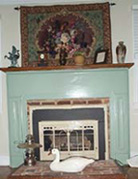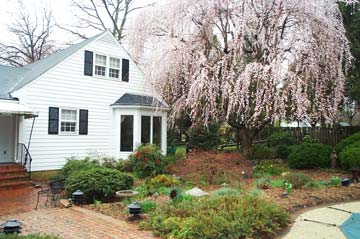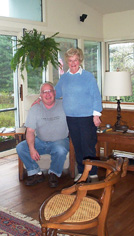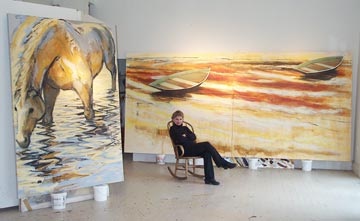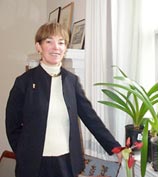|
Spring's ready. Are you? | Spring Home and Garden Services Guide Bay Weekly’s Guide to Spring Homekeeping Put In the Flowers, Take Out the Trash. 1. Get inspired on the House and Garden Pilgrimage, where history of the past meets history in the making. There’s no better way to look at your own homestead’s possibilities than to visit some of the most fascinating homes in the region. As forsythia’s yellow fades to green, the sap rises in peony, iris and homeowner. It’s time to shake off the bareness of winter and make way for the possibilities of spring. To help focus our attention, we talked to homeowners who are greeting spring with special attention. They’ll soon have 800 or 900 visitors coming through their doors during the 66th annual Maryland House and Garden Pilgrimage. Follow their lead to make the most of spring vigor and optimism.
Cindy and Mick Blackistone of Forever Fields in Fairhaven think flowers are just right for the house tour. “My feeling is, we’ll put cut flowers around but otherwise it won’t be any different than any other May 4,” he says.
At Wild Duck Landing, near Historic London Town, getting ready for visitors requires attention inside and outside.
Inside the Edmondo house, emphasis is still on the outdoors. “I want to feel outside when I’m inside,” says Betty Edmondo. Three walls of windows in the family room make that point. In the master bedroom, a bay window was added to accommodate two large recliners that look out past a weeping cherry tree and the rock garden to a grassy, treed area and the river beyond. Even the artwork repeats the view, with watercolors painted on the scene by Elizabeth Baskerville McNaughton and an 1840 oil painting by Mary Duvall, an ancestor looking across the South River to London Town Public House and the Duvall property from a pier at Ferry Point on the north shore. The Edmondos mean for the view to last. To meet that goal, they spent two long years going through the paperwork to get an historic easement for the property so it cannot be developed. 6. If you have a great view but you can’t see from the inside, make a few changes. Add a bay window for your easy chairs as the Edmondos did. Or add windows in all the right places as Carole Bolsey and Twig Johnson did at Waterfields in Galesville. Waterfields
View plays an important role at Waterfields. A decade ago, the house itself was a scene of controversy with a builder who failed to meet the aesthetic requirements and covenants of nearby historic Tulip Hill (also on the tour). With community support and intense dedication, Carole Bolsey and Twig Johnson were able to cut through a knot of nine lawsuits and counter-suits to purchase the property and create a new view for themselves and their neighbors. Today, the gravel road leading to the house and studio reveals land rolling down through green fields to the house below as if the beauty of it happened by chance. In fact, the house was lowered by three feet and moved farther downhill to settle into a natural swale like a boat between rolling waves. The house is further insinuated into the landscape through a garden approach that pleases the eye and gives away the artistic nature of the owner. From the glassed front door the view is double. Inside we see Bolsey’s large paintings of landscapes in unexpected colors that feature the familiar, simple shapes of barns or small boats. These appear in tandem with the real-life view of fields, woods, the road into Galesville and water through windows as large as the paintings. The house seems only a lull caught between waves. “We lived on Capitol Hill in a tiny townhouse for three and a half years while searching like refugees for some land and a barn with little or no house,” says Bolsey. Chance brought the artist and her environmentalist husband to the Galesville site. Persistence brought them and the house into harmony with the land and the neighbors. But it was purple martins that made the house a home. “Four springs ago,” relates Bolsey, “I noticed purple martins zooming in under the eaves. But they had no place to lodge. After I made little platforms, they moved in, nested and raised their babies as we watched. We got to hear their chitter-chatter all day long. We got to see the babies learn to fly. “Now this is my home. And add reason number two. Airfares are so cheap that I can fly my beloved nieces and nephews here from all over the country for archery, quilt-making, riding the lawn mower and fishing.”
In this home that is also a working studio, Bolsey wants tour visitors to enjoy the freedom of seeing artwork where it is made. In the kitchen, abounding with small paintings, she wants visitors to see the immediacy of living with artwork. In the living room, where large paintings live in harmony with wall-sized windows, she wants visitors to bask in the harmony between art and nature. To help nature along, Bolsey has put in a garden that flows down a wave of land to meet the front door. “I hope you feel that you’re strolling through a landscape when you to come to the house,” she says. “Perennial beds soften the contours and integrate the house with the cadence of the rolling hills. It could flow. It could almost be there by itself. It’s a little wild. I don’t ever want it to look manicured.” Inside, Bolsey says, “the house is like a raw canvas. Art and simple things co-exist to make a comfortable home. Every chair has a good reading light. As much as my artwork, my house, my gardens, quilts, food — all are ways of ‘making.’” Before the house tour, but also for a May wedding planned at the house, Bolsey will complement iris, thyme, hooded aconitum and salmon pagoda flowers by putting in “as many pink and white annuals as I can find.” 7. Go native. Set trees and bushes free of invasive, entangling honeysuckle. Plant native varieties instead. Find out which plants to avoid and which to favor from U.S. Fish and Wildlife’s booklet Plant Invaders of Mid-Atlantic Natural Areas. Consult the booklet on-line at www.nps.gov/plants. Jubilee Farm Way down at the southern tip of the state, part-time Annapolitan Maggie O’Brien has been working on 140 acres of nature at Jubilee Farm for about as long as she’s been president of St. Mary’s College of Maryland. “I love a big project,” says O’Brien, who shares the farm with her husband James Grube and two college-aged sons. “I am a gardener. The pool is a good 200 paces from the back of the house, and I’ve spent the last six years integrating the pool and the house across knolls and a ravine. I drew it out on grid paper to start, and, with persistence, it has fallen out almost as planned.”
The farmhouse is not large or modern, cautions O’Brien. Its past is as a prosperous farm. It’s a modest but well-tended farmhouse with several outbuildings and Amish-built barns. In style, it’s as close to French Provençal as you’ll find in this county. “But being inside is not important to me,” says O’Brien. “If I can squeeze in an hour per day in the garden, I’m happy. In the fall I can manage five or more hours on a weekend to put the gardens to bed for the season. In the spring I need help. Two boys work with me, and I hire the lacrosse team one day a year to do some heavy work.” Moving 50 tons of rock using a front-end loader three years ago required only the help of one female student. O’Brien put in a series of three retention ponds when she discovered heavy rains were creating a gouge across the land. “It works perfectly to filter the fertilizers and maintain water quality,” says O’Brien. “And we have waterfalls between ponds when it rains.” Last year, O’Brien put in 15,000 daffodils. That’s in addition to thousands put in by the previous owner. The result allows the continuation of an old tradition at Jubilee Farm. On the day of the tour, each visitor will be given a small bag of Jubilee jonquils along with some historic tidbits. They will be gifted with the rich and magnificent scents of sweet locust and flowering lilacs. They’ll see the beginnings of a vineyard, but there won’t be wine samplings — this year. 8. Invite company to share the contentment of your home. Give them gifts from nature and history. All it takes is a trip to the garden or a visit to an old story. Add a photo or painting to make the memory special. |
||||||||||||||
© COPYRIGHT 2003 by New Bay Enterprises, Inc. All rights reserved.
Last updated April 17, 2003 @ 1:57am



